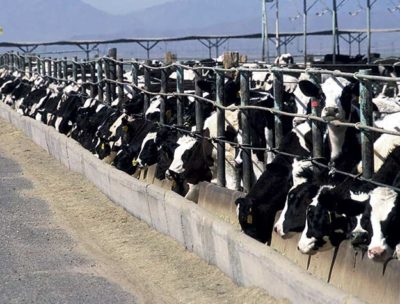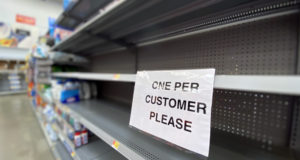|
Listen To The Article
|
 Most people don’t know and may not even care where their food actually comes from. You may imagine a peaceful farm where the animals quietly graze in lush pastures and are comfortably nestled in warm stalls with fresh water and straw bedding. While this picturesque setting is, in fact, the ideal way to raise our food animals, it is often far from a reality.
Most people don’t know and may not even care where their food actually comes from. You may imagine a peaceful farm where the animals quietly graze in lush pastures and are comfortably nestled in warm stalls with fresh water and straw bedding. While this picturesque setting is, in fact, the ideal way to raise our food animals, it is often far from a reality.
Many of today’s food animals (cows, pigs, chickens, etc.) are raised in confined animal feeding operations, or CAFOs. These over-populated animal housing operations cram thousands of animals in spaces hardly appropriate for a few hundred. Aside from the fact that the living situations are downright cruel, the operations themselves are destroying the quality of our food supply, wreaking havoc on the environment and promoting a string of super-bacteria that is impacting our very lives.
“The present system of producing food animals in the United States is not sustainable and presents an unprecedented level of risk to public health and damage to the environment, as well as unnecessary harm to the animals we raise as food,” said Robert Martin, the Director of the Pew Commission on Industrial Farm Animal Production.
There’s no doubt that nobody wants to consider that their steak was once mooing in a field somewhere, yet it’s time for Americans to wake up and take a closer look at how these CAFOs are affecting our food, our environment and our health.
CAFOs Pollute the Environment
Over 3 million tons of animal manure is doled out of CAFOs each year. That is twice as much as the entire U.S. population produces. Unfortunately, many of these CAFOs have horrible management systems in place to cope with the enormous amount of animal waste. And keep in mind, this waste is often treated with a number of medications, antibiotics and other drugs to keep the animals healthy while in confinement. The containment systems often leak or spill and the disposal methods are poorly operated, resulting in an overwhelming amount of pollution to the nearby waterways and land.
Many of the nearby bodies of water are considered “dead zones” as they are completely devoid of any marine life due to over-pollution. And the land value of surrounding rural communities often plummet thanks in part to the occurrences of acid rain as a result of the high levels of manure-producing ammonia.
Reconnect with land and food sources, encourage food stability and independence
CAFOs Promote Super Bugs
Whenever you cram thousands of animals in confined corners you are going to have disease. CAFOs compensate for this by immunizing everything. Each and every animal is treated with antibiotics to protect against salmonella, E. coli, staphylococcus aureus, otherwise known as MRSA whether they are sick or not. The result is the evolution of a super-strain of these dangerous diseases, the same diseases that affect us. And with each and every bite, we too get a healthy dose of those antibiotics, which only further contributes to degrade our own natural ability to fight bacteria.
To make matters worse, CAFO animals are often treated with growth-promoting hormones and medications. In fact, over 70 percent of all antibiotics and related drugs that our country produces go straight to CAFO farms to treat animals. Once again, every time you eat a CAFO-raised animal, you too are getting a healthy dose of unnecessary medications.
CAFO Animals are Not Nutritious
There is absolutely nothing natural about cramming thousands of animals in ridiculously tight conditions. These animals are not allowed to roam freely and forage, which is how their digestive tracts are designed to work. And, to fatten them up in a hurry, they are fed feeds comprised of unnatural ingredients such as genetically modified soy and corn that their bodies aren’t even meant to break down. So in essence, you have an animal living in an unnatural environment, eating unnatural food. Would it make sense that the animal would have the same nutritional value of cows, pigs or chickens raised in a natural environment? Of course not. The CAFO animals are hopping with medication and antibiotics, making them and their byproducts such as milk and eggs, far inferior nutritionally than to those of decades ago.
An Alternative Solution
While CAFO operators will lead you to believe that these operations are necessary for producing meat in today’s world, there are several options that not only produce better, more nutritious food, but also help preserve the environment as well.
Smart pasture operations (SPO) combine the modern technologies of mass food production with sustainable practices. Where CAFOs go against the natural order of various systems (animal feeding, habitat and environment) SPOs work with those systems to produce higher quality food. A typical CAFO will house thousands of animals whereas an SPO may only house a few hundred. Because conditions are less crowded, animals are free to roam, which aids in their natural digestion. Feeds are often produced onsite and are comprised out of the foods these animals were designed to eat and due to far less crowding, antibiotic use is minimal. And manure can often be turned into fertilizer rather than disposed of.
Another option is that of a “hoop barn.” These low-cost tunnel-shaped structures often house pigs. They are far less crowded, are bedded with straw and manure is often recycled into useful fertilizer.
While SPOs and hoop barns yield less product than that of CAFOs, the actual yield per animals is more than that of CAFO-raised animals, making them a smarter option. Plus, they are far more environmentally friendly and the product is more nutritious.
The ideal situation would be to purchase meat and dairy products from a local organic farmer. Yet in most cases, that isn’t an option. But SPOs and structures like hoop barns are alternative options that are a step in the right direction.
The only way to stop CAFOs from poisoning our environment, diminishing the quality of our food and aiding in the rise of super-bacteria is to stop buying their product. Try to seek out local farmers and shop at farmer’s markets often. When buying from a grocery store, look for these labels to ensure that your food didn’t come from a CAFO:
- Certified Humane Raised and Handled
- Animal Welfare Approved
- Food Alliance
- American Humane Certified
- Leaping Bunny
- USDA Organic
 Off The Grid News Better Ideas For Off The Grid Living
Off The Grid News Better Ideas For Off The Grid Living




